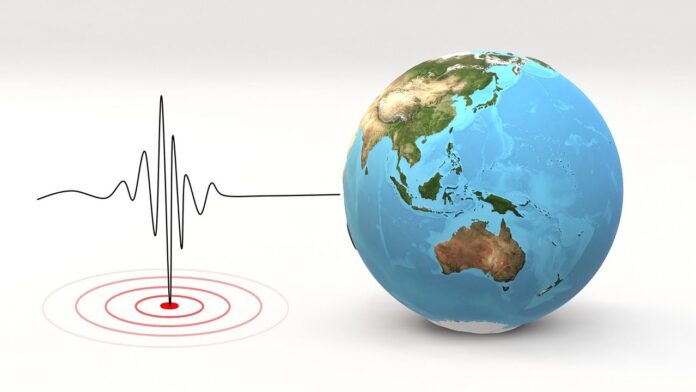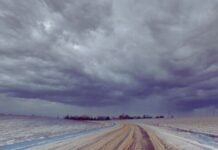As the Earth’s tectonic plates collide, grind against each other, and submerge beneath one another, they release the accumulated energy through massive earthquakes. These seismic events can shake the ground, trigger volcanic eruptions, reshape mountains, and even generate tsunamis.
Since scientists developed the ability to measure earthquake magnitude in the early 1900s, we’ve witnessed some truly colossal quakes that have left a significant impact on our planet. These formidable earthquakes are often referred to as “megathrust” earthquakes and are recognized as the most powerful seismic events worldwide. A substantial portion of these powerful earthquakes has occurred in a select few subduction zones situated along the seismically active “Ring of Fire” encircling the Pacific Ocean, where tectonic plates plunge beneath one another.
Read More: Deadliest Natural Disasters in History
From the devastating Sumatran earthquake and tsunami of 2004 to an enormous tremor in Siberia that, fortunately, resulted in no casualties, we’ll explore the 20 largest earthquakes ever recorded according to the data provided by the U.S. Geological Survey (USGS).
1. Valdivia, Chile; 1960; Magnitude 9.5
The most significant earthquake ever documented occurred on May 22, 1960, in Valdivia, Chile, claiming the lives of approximately 1,655 people. This devastating event left thousands injured and forced millions into homelessness. Southern Chile faced staggering damages, totaling $550 million.
The earthquake’s impact extended beyond Chile, as it triggered a tsunami that wrought havoc in other parts of the world. Hawaii saw 61 lives lost, Japan recorded 138 casualties, and the Philippines mourned the loss of 32 lives.
This seismic catastrophe took place in an area where the Nazca Plate subducts beneath the South American Plate, specifically on the Peru-Chile Trench.
2. Prince William Sound, Alaska; 1964; magnitude 9.2
A significant earthquake and the subsequent tsunami it triggered claimed 128 lives and resulted in approximately $311 million in property damage. This seismic event had a profound impact on various towns, with Anchorage, located roughly 75 miles (120 km) northwest of the epicenter, experiencing particularly heavy damage. The earthquake occurred on March 27, 1964, along a fault line between the North American and Pacific plates, known for its seismic activity, and the shaking persisted for approximately 3 minutes.
In Anchorage, landslides were a major source of destruction. Massive slides wreaked havoc in the downtown business district, leading to disruptions in essential infrastructure such as water mains, gas lines, sewer systems, telephone networks, and electrical grids across the region.
3. Sumatra-Andaman Islands, 2004, magnitude 9.1
This earthquake ranks as the third-largest seismic event in history, with the only one surpassing it being the 1964 earthquake in Prince William Sound, Alaska (which is the second-largest). The toll it took was staggering, with nearly 300,000 people either confirmed dead or presumed so. Additionally, about 1.2 million individuals found themselves displaced as a result of the earthquake and the subsequent tsunami that struck across ten countries in Southeast Asia and East Africa.
The intensity of the shaking was particularly pronounced in Banda Aceh, but the most devastating consequence of this earthquake was the tsunami it unleashed, surpassing all previous records for tsunami-related fatalities up to that point. The tsunami’s effects were observed on tide gauges spanning the Indian, Pacific, and Atlantic oceans, underscoring its far-reaching impact.
Read Also: Earth Tremors Mystery Solved
This massive earthquake occurred on the day after Christmas, where the Indian and Burma tectonic plates converge. It stemmed from the release of stress that had built up as the Indian Plate subducted beneath the Burma microplate. The extensive fault zone responsible for this event was located offshore and extended the length of California, as noted by the USGS.
4. Tōhoku, Japan; 2011; magnitude 9.1
On March 11, 2011, a massive magnitude 9.1 earthquake unleashed a devastating tsunami that resulted in a tragic toll. More than 15,700 people lost their lives, with over 4,600 individuals reported as missing. Additionally, the earthquake left more than 5,300 people injured and forced more than 130,900 individuals out of their homes, according to data from the USGS.
The scale of destruction was extensive, with over 332,000 buildings, 2,100 roads, 56 bridges, and 26 railways suffering damage as a direct consequence of the quake. Beyond the immediate impact, the earthquake also inflicted severe damage on the Fukushima Daiichi Nuclear Power Plant, leading to one of the most significant nuclear disasters in history. This earthquake stands as the largest ever recorded in Japan, and its economic cost is estimated at a staggering $309 billion in damages.
In the weeks following the main earthquake, the region experienced a series of powerful aftershocks, some with magnitudes exceeding 6.0 and even reaching 7.0. The initial quake also generated tsunami waves that traveled as far as Hawaii, California, and the Galapagos Islands. Remarkably, the seismic activity even reached distant Antarctica, where the quakes caused substantial fractures in large sections of the Sulzberger Ice Shelf, as reported by the USGS.
The root cause of this seismic event was thrust faulting near the Japan Trench, which marks the boundary between the Pacific and North American tectonic plates.
5. Kamchatka Peninsula, Russia; 1952; magnitude 9.0
On November 4, 1952, history witnessed its first documented magnitude 9.0 earthquake, which occurred off the eastern coast of Kamchatka. This powerful seismic event gave rise to a local tsunami that reached an astonishing height of 43 feet (13 meters). The repercussions of this tsunami were felt as far away as Crescent City, California.
Remarkably, there were no casualties reported, but the impact was significant. In Hawaii, property damages were estimated to be as high as $1 million, which, when adjusted for today’s inflation, equates to approximately $11.12 million. The tsunami’s force hurled boats onto the shore, caused houses to collide, obliterated piers, eroded beaches, and displaced road pavement.
6. Offshore Maule, Chile; 2010; magnitude 8.8
On February 27, 2010, central Chile was struck by a devastating earthquake and tsunami. This natural disaster claimed the lives of at least 500 individuals and left approximately 800,000 people without homes. The impact was felt by more than 1.8 million people, and the collective economic loss was estimated at a staggering $30 billion.
Similar to several other earthquakes on this list, this tremor occurred along the highly active boundary between the Nazca and South American tectonic plates, where the release of seismic energy can result in incredibly powerful shaking.
It’s worth noting that this earthquake occurred just a little over a month after the tragic magnitude 7.0 earthquake in Port-Au-Prince, Haiti, which led to the loss of more than 200,000 lives.
7. Off the coast of Ecuador, 1906, magnitude 8.8
On January 31, 1906, a devastating earthquake of magnitude 8.8 struck off the coast of Ecuador and Colombia, unleashing a powerful tsunami that resulted in the loss of 500 to 1,500 lives. The impact of the tsunami extended along the coast of Central America and even reached as far as the shorelines of San Francisco and Japan.
This earthquake occurred along the boundary where the Nazca Plate and the South American Plate meet. Due to its occurrence over a century ago, historical records are somewhat limited. However, as per reports from the USGS, witnesses in Honolulu Bay described a dramatic event. A significant surge of water surged into the bay, causing all the steam and sailboats present to abruptly change course. Subsequently, a rapid flood tide swept inland.
8. Rat Islands, Alaska; 1965; magnitude 8.7
On February 4, 1965, Alaska, a state only six years old at the time, experienced a substantial earthquake that triggered a tsunami with waves exceeding 30 feet (10 meters) in height. Remarkably, despite its magnitude, the earthquake caused minimal damage. This was primarily due to its remote location at the tip of the Aleutian Islands. However, the tsunami’s effects were felt far and wide, reaching as far as Hawaii and even Japan.
This seismic event was the result of the Pacific Plate subducting beneath the North American Plate along the Alaska-Aleutian megathrust, a region known for numerous megathrust earthquakes. The earthquake did produce some notable effects, including the cracking of wooden structures and the splitting of an asphalt runway. Additionally, hairline cracks appeared on the runways at the U.S. Coast Guard’s Loran Station.
9. Assam-Tibet, 1950, magnitude 8.6
On August 15, 1950, a powerful earthquake struck the eastern regions of Tibet and Assam, India, resulting in a tragic loss of at least 1,500 lives. The earthquake’s impact on the area was profound, marked by ground cracks, extensive landslides, and the emergence of sand volcanoes. Its tremors were felt not only in the neighboring Chinese provinces of Sichuan and Yunnan but also as far away as Kolkata, India.
One of the notable consequences of the quake was the occurrence of large landslides that obstructed rivers. When these rivers eventually broke through the debris barriers, they unleashed waves that inundated several villages, claiming the lives of hundreds of people.
This earthquake is commonly referred to as the Assam-Tibet earthquake or simply the Assam earthquake, despite its epicenter being located in Tibet. It occurred at the intersection of one of the most dynamic continental plate collisions on Earth, where the Indian Plate forcefully collides with and subducts beneath the Eurasian Plate. This slow-motion collision played a crucial role in shaping the immense Himalayan mountain range.
10. Off the west coast of northern Sumatra, 2012, magnitude 8.6
On April 11, 2012, a significant earthquake with a magnitude of 8.6 struck off the coast of northern Sumatra. One distinctive aspect of this earthquake was its epicenter location, which was a few hundred miles off the coastline. As a result, it generated intense shaking in only a handful of populated areas, including Banda Aceh and Meulaboh in Indonesia. Fortunately, it led to only minor structural damage in these urban areas, as reported by the USGS. However, the effects of the earthquake were felt as far away as Mumbai, India, and Broome, Australia.
Direct casualties attributed to the earthquake were relatively low, with two people losing their lives directly due to the quake, while eight individuals succumbed to heart attacks, and 12 others sustained injuries.
11. Northern Sumatra, Indonesia; 2005; magnitude 8.6
The region surrounding Sumatra is known for its high seismic activity, as the Indonesian island lies along the volcanically active Pacific Ring of Fire.
In this geologically unsettled area, where the Australian Plate meets the Sunda Plate, a tremendous release of energy occurred on March 28, 2005, when a magnitude 8.6 earthquake struck just 48 miles (78 km) west of Singkil, at a depth of 18 miles (30 km). The impact of this seismic event was substantial, resulting in the tragic loss of more than 1,300 lives, with an additional 340 individuals sustaining injuries. Hundreds of buildings, primarily on the island of Nias, were destroyed in the process. The earthquake’s tremors reached as far as India and Sri Lanka.
The root cause of this earthquake can be attributed to the movement of the Australian Plate, which is steadily shifting northeastward at a rate of 2 inches (50 millimeters) per year, subducting into the mantle at the Sunda Trench. According to the USGS, this massive quake occurred in the wake of the significant Indian Ocean earthquake of 2004, as the faults in the region continued to adjust in response to the seismic activity triggered by that event.
12. Andreanof Islands, Alaska; 1957; magnitude 8.6
On March 9, 1957, a significant earthquake with a magnitude of 8.6 struck off the coast of the Andreanof Islands, which are part of the Aleutian Islands. The epicenter of this earthquake was located approximately 53 miles (86 km) southeast of Adak, Alaska, a small village with only a few hundred residents and the southernmost town in the state.
Remarkably, no lives were lost as a direct result of the earthquake, but it did inflict damage on the region. Two bridges were destroyed, and a road in Adak suffered a lengthy crack. Additionally, some houses sustained damage.
One of the most striking consequences of the earthquake was the generation of a tsunami with a towering height of 49 feet (15 meters), which struck the nearby Scotch Cap lighthouse. Another tsunami, reaching a height of 26 feet (8 meters), washed away oil lines in Sand Bay. Subsequently, the tsunami traveled as far as Hawaii, where it led to the destruction of two villages, and reached San Diego, causing some property damage along its path.
13. Unimak Island, Alaska; 1946; magnitude 8.6
On April 1, 1946, a substantial earthquake with a magnitude of 8.6 occurred on Unimak Island. Despite its considerable magnitude, this earthquake surprisingly did not result in the destruction of any buildings. However, it did unleash a towering tsunami, reaching an astonishing height of 115 feet (35 meters), which tragically swept away a lighthouse along with its five occupants, as reported by the USGS.
As the tsunami traveled across the ocean, it eventually reached Hilo, a town located on the Big Island of Hawaii. There, it had devastating consequences, claiming the lives of 159 individuals and causing approximately $26 million in property damage.
Unimak Island is part of the Aleutian Islands, a region situated along the restless Ring of Fire, much like many other areas that have experienced significant earthquakes on this list.
14. Banda Sea, Indonesia; 1938; magnitude 8.5
On February 1, 1938, a substantial earthquake, measuring 8.5 on the magnitude scale, shook the seafloor approximately 88 miles (141 km) northwest of Tual, Indonesia. Surprisingly, despite the considerable strength of this earthquake, the damage it caused was relatively minor.
Reports from the region indicate that residents of the Banda and Kai islands felt the tremors. In the city of Tual, some glassware broke, and a pendulum came to a halt as a result of the shaking.
15. Atacama, Chile; 1922; magnitude 8.5
On November 11, 1922, a colossal earthquake with a magnitude of 8.5 struck the Atacama Desert, situated on the border between Argentina and Chile. Despite the epicenter being located on land, the intensity of the earthquake was so profound that it triggered a tsunami. This tsunami, as reported by news accounts of the time, resulted in the tragic loss of hundreds of lives.
16. Kuril Islands, Russia; 1963; magnitude 8.5
Limited information is available about the earthquakes that occurred in the remote Kuril Islands on October 13, 1963. This volcanic island chain extends between Russia’s Kamchatka Peninsula and Japan’s Hokkaido.
Fortunately, there were no reported fatalities, damages, or injuries resulting from this earthquake. However, it did generate a tsunami that reached the northern Pacific Ocean.
17. Near Kamchatka Peninsula, 1923, magnitude 8.4
There’s limited information available about the earthquake that had a magnitude of 8.4 and struck off the eastern coast of Kamchatka, Russia, on February 3, 1923. This region in the Russian Far East is sparsely populated and situated near the Kuril-Kamchatka Trench. This trench marks the point where the Pacific Plate subducts beneath the Okhotsk Plate, which was once believed to be part of the North American Plate.
Fortunately, there were no reported injuries or fatalities resulting from this earthquake. Nevertheless, it did trigger a relatively modest tsunami, as reported by the USGS.
18. South of Sumatra, 2007, magnitude 8.4
On April 12, 2007, an earthquake of magnitude 8.4 occurred roughly 76 miles (122 km) off the coast of Bengkulu, Indonesia, on the island of Sumatra. This significant seismic event was the result of thrust faulting along the boundary between the Sunda and Australian tectonic plates.
Tragically, around 25 individuals lost their lives, and more than 161 sustained injuries as a result of this earthquake. The cities of Bengkulu and Sumatera Barat bore the brunt of the damage, with over 20,000 buildings suffering various degrees of destruction, as reported by the USGS.
This earthquake marked the fourth instance of a magnitude 7.9 or higher earthquake striking the general region during that decade. The area was still undergoing geological transformation following the massive earthquake that occurred just after Christmas Day in 2004 (as detailed in entry #3).
19. Arequipa, Peru; 2001; magnitude 8.4
On June 23, 2001, a substantial earthquake, measuring a magnitude of 8.4, struck just 4 miles (6 km) from the coastal town of Atico, Peru. This powerful seismic event had devastating consequences, with at least 74 lives tragically lost. A significant portion of these casualties resulted from the ensuing tsunami. Over 2,600 individuals sustained injuries, and the strong ground shaking caused damage to more than 50,000 homes.
The earthquake occurred at the boundary between the Nazca and South American tectonic plates. The Nazca Plate, moving northeastward at approximately 3 inches (78 millimeters) per year, collides with and subducts beneath the South American Plate, as explained by the USGS. The ground shaking stemming from this seismic activity was felt as far away as La Paz, Bolivia.
20. Sanriku-Oki, Japan; 1933; magnitude 8.4
On March 2, 1933, a significant earthquake with a magnitude of 8.4 occurred near the Sanriku region of Japan, as documented by the USGS. The epicenter was located approximately 180 miles (290 kilometers) offshore of Honshu, Japan.
The most tragic consequences of this earthquake were attributed to the tsunami it generated. The tsunami swept away 3,000 homes and left 2,000 others in ruins. It also produced towering waves, reaching nearly 100 feet (29 meters) in height, which inundated parts of Honshu, Japan.
Several decades later, the same general region would experience another colossal earthquake, registering at a magnitude of 9.0, leading to the Tōhoku earthquake and tsunami in 2011.
This area falls within the Pacific Ring of Fire, an extensive horseshoe-shaped belt stretching over 25,000 miles (40,000 km). It is renowned for its frequent seismic activity and volcanic eruptions. The ring traces the boundaries of the Pacific Plate as it collides with neighboring plates, with the region around Tōhoku being where the Pacific Plate converges with the North American Plate.














![Technical Aspects of 844 Area Code in 2024 [Detail Guide] 844 Area Code](https://articleify.com/wp-content/uploads/2024/01/844-Area-Code-150x150.jpg)














